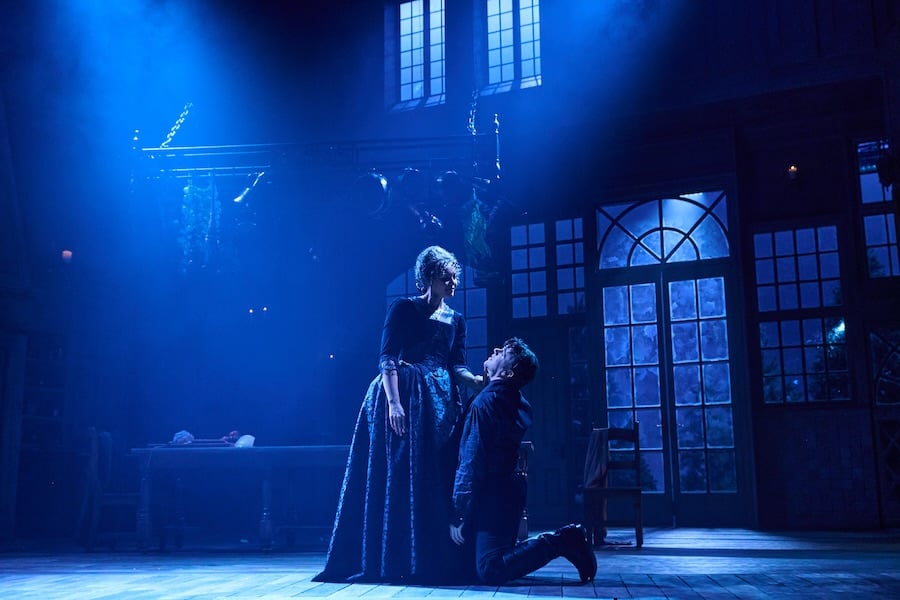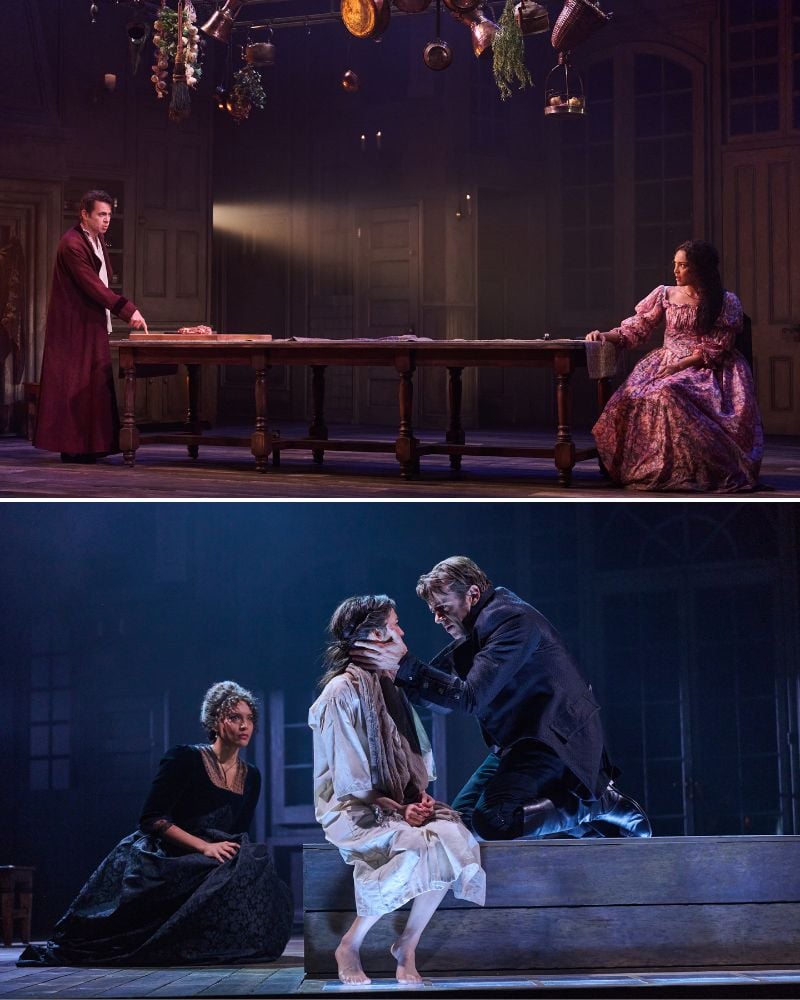There is always risk involved in adapting a beloved classic. Consider the Ford Edsel, “New” Coke, or vegetable Jell-O. Literary adaptations can be especially fraught, as any director of Shakespeare knows. The sheer range of subject matter that may be involved — language, character, plot, theme, style, etc. — provides plenty of opportunity for missteps or simply offending audience expectations. The best adaptations tend to illuminate and magnify significant elements of the original and endow them with contemporary relevance, clarity, and heightened meaning. Less successful adaptations may veer so far from the original context that characters, themes, and plot elements are no longer recognizable and lose their connection to the original altogether. Emily Burns’ Frankenstein, running at Shakespeare Theatre Company through June 29, falls somewhere in between. The playwright-director bravely recontextualizes important motifs in the classic story — the obligations of parenthood and what happens when we aren’t loved — but ultimately fails to develop them in a way that adds new meaning or clarity. This “creature,” as Burns calls her play in the Director’s Notes, isn’t really sure what it wants to be.

It should be noted up front that STC describes Burns’ work as “based upon” Mary Shelley’s famous gothic novel of 1818, but it shares characteristics common to all adaptations: characters and significant elements of plot, theme, language, and context are derived from the original and, in this case, the title itself (although without Shelley’s subtitle “Or the Modern Prometheus,” which may be significant). Whereas Shelley’s novel focuses centrally on the relationship or lack of relationship between Victor Frankenstein and his creature, Burns homes in on the relationship between Victor (Nick Westrate) and his childhood companion-cum-wife, Elizabeth (Rebecca S’manga Frank), a relationship given rather superficial treatment in the novel. This is both a strength and a weakness of Burns’ play. She gives Elizabeth a voice and, ultimately, a spirit she does not possess in the original story, but far too much of this Frankenstein revolves around heated verbal battles between these two that do little to advance the plot and sometimes verge on the melodramatic. If there is a nefarious creature in this play, it may be this toxic relationship and the way it illuminates power imbalances between men and women.
That may be Burns’ point, but the fact that the play’s central argument is unclear is part of the problem. Competing with the toxic relationship between Victor and Elizabeth, driven mostly by Victor’s failure to act as an adult, is the motif of creatureliness and whether Victor, by his failure to accept any kind of responsibility — as a husband, a father, or a creator — is himself the real monster of the story. Here, Burns employs the neat device of voice doubling, so that we occasionally hear original lines from the novel spoken by one of the two protagonists (Victor or Elizabeth) combined with the offstage voice of the Creature. This striking technique creatively underlines ideas Burns wishes to emphasize. At the end of Act One, when Elizabeth (once again) implores Victor to make good on his long-delayed promise to marry her, we hear the combined voices of Victor and the Creature respond, “I will make you a wife” — just what Victor in the novel promised his unhappy creation, but later reneged on.

But there’s some confusion here, too. Since we sometimes hear Victor’s voice doubled with that of the Creature and sometimes Elizabeth’s, are we to identify both of them with the Creature? Does the Creature live inside everyone? In her Director’s Notes, Burns tells us that her play is drawn from Shelley’s novel but “reframed through a contemporary psychology.” Throughout the play, until the very end, Burns seems to suggest there may not be any actual creature. Elizabeth, after reading Victor’s diaries, is convinced of it: The monster exists only in her husband’s overheated mind. (“You created a story that has ruined our lives,” she says…. “The enemy was you the whole time.”) Yet, in Burns’ final scene (spoiler alert), the Creature (Lucas Iverson) does make an appearance, looking for all the world like Victor himself, only selfless, compassionate, and responsible, as Victor is not. Are we experiencing a mass hallucination, or is this Victor doppelganger for real? The interior, psychological narrative Burns has set up seems to clash with the sudden appearance of a real “fiend,” and it’s hard to know what to make of this. If indeed the Creature was “real” all the time, do we need to go back and reframe our thinking about the perpetual adolescent (Victor Frankenstein) we’ve been watching onstage for the past two hours? Does he deserve some sympathy despite his tantrums?
As presented by Westrate under Burns’ direction, Victor is more spoiled child in need of spanking than serious man of ambition who employs considerable scientific skills to create a new being. It’s hard to imagine him doing anything other than drinking, lounging, and arguing, which is mostly what we see onstage. While Burns admirably focuses on a significant motif in the novel — Victor’s failure to take responsibility for his creation or to show it any love or compassion — the character she and Westrate present in the play is almost impossible to take seriously or sympathetically. (At one point, Westrate’s Victor literally throws a childlike tantrum, lying on the floor and pounding his fists.) If we can’t take a character seriously, it’s hard to care very much about his inner turmoil or external adversaries.
The same is not true of S’manga Frank’s Elizabeth, who has more agency and a much larger presence here than in the novel, where she is murdered by the Creature on her wedding night. Nevertheless, so much of her stage time is spent trying to cajole answers out of Westrate’s Victor (about his whereabouts, about marriage, about having a child, or where he has taken it) that she inevitably comes across as passive (or simply reactive) and disempowered. Why an intelligent, attractive woman like her would spend five minutes with a man like this Victor, much less wait on him for years at a time, is hard to fathom. But perhaps family ties run deep (they are adoptive brother and sister).
The introduction of humor (which the Gothic novel does not really have) and colloquial language are noble attempts to update and to some extent recontextualize Shelley’s work. However, the language often falls into modern slang (“those guys,” “Are you okay?” etc.), including the F-bomb, which (again) undermines the seriousness of the story and clashes with the early 19th-century set and costumes. The introduction of humor, while refreshing here and there, especially in the play’s early moments, becomes an issue as the play struggles to find its tone, navigating at times between flippancy, seriousness, and melodrama. (On the night this reviewer attended, there was involuntary laughter during the big reveal scene, when the creature suddenly makes his appearance — presumably meant to be a serious and defining moment in the play.)
The gothic set (designed by Andrew Boyce) and early 19th-century costumes (by Kaye Voyce) admirably evoke the original context of Shelley’s novel. Boyce’s gigantic gray set — huge “stone” fireplace, soaring walls, and tall French windows — is the perfect receptacle for Neil Austin’s dim, moody lighting (which moves into a brighter key in the second act). Andre Pluess’ sound design, including the voice doubling, is very effective, as are surtitles by Elizabeth Barrett projecting selected lines from the novel above the proscenium.
The first of these lines, taken from the Creature in the novel, but seemingly applied to Victor here — “I never felt the safety of unconditional love” — is, presumably, meant to set the theme for Burns’ entire production. But does it? Never do we feel that Victor’s real problem is not having been loved — he seems instead to have been spoiled — and Elizabeth’s frustration appears to stem more from Victor’s intransigence and irresponsibility, as well as her own failed expectations, than from any deep-seated insecurity about love. Perhaps Burns simply opens up too many lines of inquiry, making it impossible to fully develop any of them. And yet. An important line of exploration in the novel, more relevant today than ever, is surprisingly never touched on in this Frankenstein. That is the ethical implications of technology and the responsibilities of those who both use it and create it. In an era of rapidly developing Artificial Intelligence, machine learning, gene editing, and robotics, to name only a few scientific advancements, questions about our relationship to technology and the limits placed upon it (or not) are of central importance for civilization itself. The same was true in Mary Shelley’s day, when experiments in galvanism (the study of the effects of electricity on the body) and new understandings of human anatomy and physiology were hotly debated, including in Shelley’s own circles. It’s why technology and science play such a large role in a novel written by a teenager. This seems a missed opportunity for a Frankenstein that purports to reframe Shelley’s story for our own time.
Unfortunately, Emily Burns’ tale is dominated by an adolescent very different from the teenage Mary Shelley, one not nearly so mature, not nearly so talented. This Victor Frankenstein is no modern Prometheus. But he might be Holden Caulfield.
Running Time: Approximately two hours and 20 minutes, including one intermission
Frankenstein plays through June 29, 2025, at Shakespeare Theatre Company’s Michael R. Klein Theatre (formerly the Lansburgh) – 450 7th Street NW, Washington, DC. Tickets (starting at $35) are available at the box office, online, by phone at (202) 547-1122, or through TodayTix. Shakespeare Theatre Company offers discounts for military servicepeople, first responders, senior citizens, young people, and neighbors, as well as rush tickets. Contact the Box Office or visit Shakespearetheatre.org/tickets-and-events/special-offers/for more information.
The Asides program for Frankenstein is online here.
COVID Safety: All performances are mask recommended. Read more about STC’s Health and Safety policies here.
Frankenstein
Written and directed by Emily Burns
Based on the novel by Mary Shelley
CAST
Elizabeth: Rebecca S’manga Frank
Victor: Nick Westrate
Justine/Esther/Voice of Caroline, Young Victor: Anna Takayo
Creature: Lucas Iverson
Young Elizabeth/Eva (alternating): Mila Weir, Monroe E. Barnes
ARTISTIC TEAM
Playwright and Director: Emily Burns
Scenic Designer: Andrew Boyce
Costume Designer: Kaye Voyce
Lighting Designer: Neil Austin
Sound Designer/Composer: André Pluess
Projection Designer: Elizabeth Barrett
SEE ALSO:
STC announces cast and creatives for world-premiere ‘Frankenstein’ (news story, April 30, 2025)



